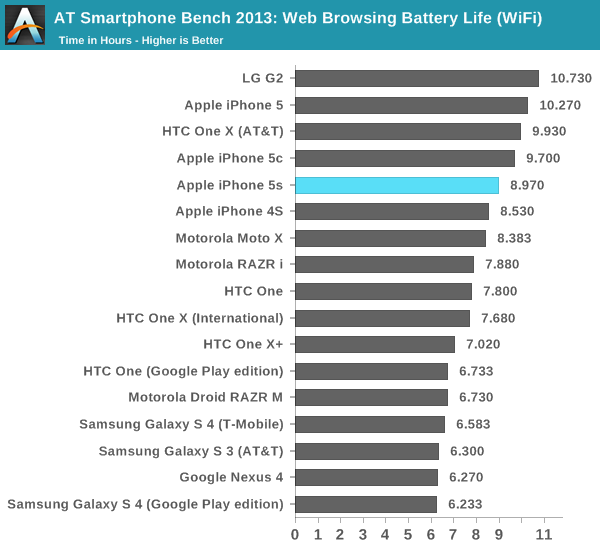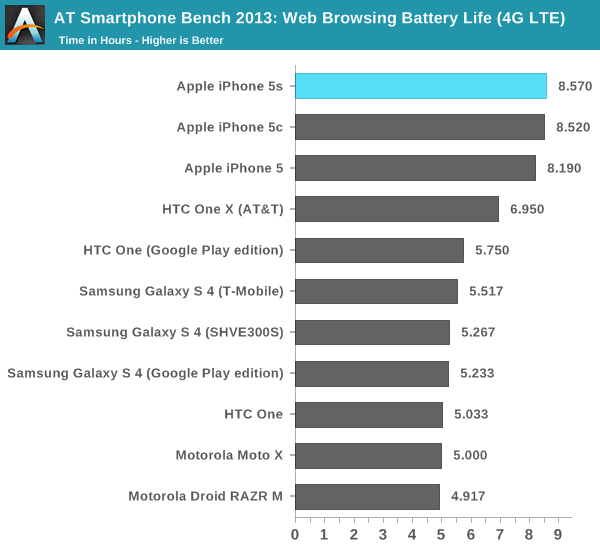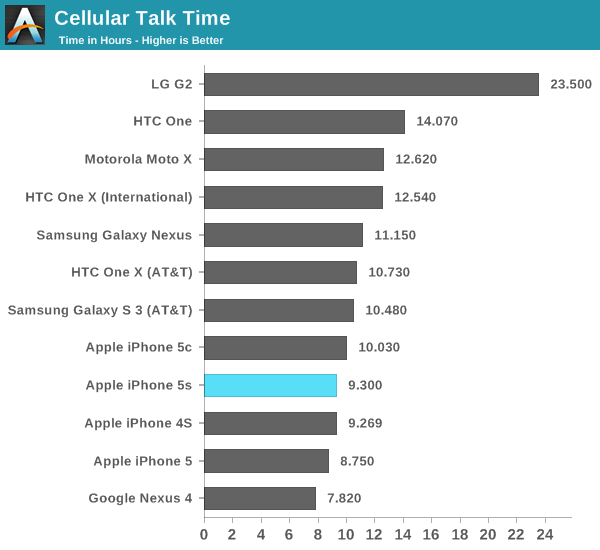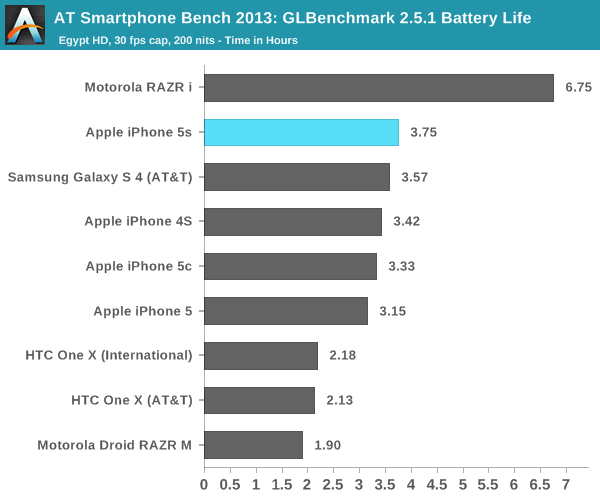The iPhone 5s Review
by Anand Lal Shimpi on September 17, 2013 9:01 PM EST- Posted in
- Smartphones
- Apple
- Mobile
- iPhone
- iPhone 5S
Battery Life
Brian did some excellent sleuthing and came across battery capacities for both the iPhone 5s and 5c in Apple’s FCC disclosures. The iPhone 5 had a 3.8V 5.45Wh battery, while the 5s boosts total capacity to 5.96Wh (an increase of 9.35%). The move to a 28nm process doesn’t come with all of the benefits of a full node shrink, and it’s likely not enough to completely offset the higher potential power draw of a much beefier SoC. Apple claims the same or better battery life on the 5s compared to the iPhone 5, in practice the answer is a bit more complicated.
Unlike previous designs, we’ve never had a half node shrink for an s-SKU. Both the iPhone 3GS and iPhone 4S stayed on the same process node as their predecessor and drove up performance. In the case of the 3GS, the performance gains outweighed their power cost, while in the case of the iPhone 4S we generally saw a regression.
The iPhone 5s improves power consumption by going to 28nm, but turns that savings into increased performance. The SoC also delivers a wider dynamic range of performance than we’ve ever seen from an Apple device. There’s as much CPU power here as the first 11-inch MacBook Air, and more GPU power than an iPad 4.
To find out the balance of power savings vs. additional performance I turned to our current battery life test suite, which we first introduced with the iPhone 5 review last year.
We'll start with our WiFi battery life test. As always, we regularly load web pages at a fixed interval until the battery dies (all displays are calibrated to 200 nits).

The iPhone 5s regresses a bit compared to the 5 in this test (~12% reduction despite the larger battery). We're loading web pages very aggressively here, likely keeping the A7 cores running at their most power hungry state. Even the 5c sees a bit of a regression compared to the 5, which makes me wonder if we're seeing some of the effects of an early iOS 7 release here.
The story on LTE is a bit different. Here we see a slight improvement in battery life compared to the iPhone 5, although the larger battery of the 5s doesn't seem to give it anything other than parity with the 5c:

Our cellular talk time test is almost entirely display and SoC independent, turning it mostly into a battery capacity test:

You can see the close grouping of the smaller iPhones at the bottom of the chart. There's a definite improvement in call time compared to the iPhone 5. We're finally up above iPhone 4S levels there.

Our Egypt HD based 3D battery life test gives us the first indication that Rogue, at least running fairly light code, can be more power efficient than the outgoing 5XT. Obviously the G6430 implemented here can run at fairly high performance levels, so I'm fully expecting peak power consumption to be worse but for more normal workloads there's no regression at all - a very good sign.










464 Comments
View All Comments
darkich - Wednesday, September 18, 2013 - link
Anand really should be ashamed of himself.. doing the same old Java Script(software dependant to a major extent) trick over and over again, and clearly as a day, refusing to include a hardware benchmark such as GB.That way, he can keep on kissing Intel's and Apple's behind.
(Btw I actually love what Apple is doing with its custom ARM chips, and I am really looking forward to the A7X and iPad 5)
Despicable dishonesty
Dug - Wednesday, September 18, 2013 - link
Funny, you want different information than what's provided and some how you come to the conclusion that it's biased. Yet throughout your post you have nothing to back it up, and all you have added is your own personal comments against Apple. Pot calling the kettle black? And from what I can tell from you blabbering on about 64bit code, you have no educated information on iOS 7 64bit or the 64bit proc. Correct me if I am wrong and show me an app that you have developed for it. In the end it comes down to how well the product will perform, and Anand's review has shown that. And what's this comment 'Native benchmarks don't compare the new apple chip to "old 32 bit v7 chips" - it only compares the new apple chip to the old ones. What 32bit v7 chip are you talking about? And why wouldn't he compare the new chip to the old ones. And what difference does it make?Patranus - Wednesday, September 18, 2013 - link
What difference does it make if the iOS and Android use different JS engines?StevenRN - Saturday, September 21, 2013 - link
By "unbiased" you mean a review from a site like AndroidCentral or similar site?barefeats - Wednesday, September 18, 2013 - link
Excellent review. I'm sharing it with every iPhone freak I know.jimbob07734 - Thursday, September 19, 2013 - link
I'm sure not gonna be that guy that buys the first Samsung 64 bit chip they slap together to match the A7. I doubt they have even started working on it until last week.NerdT - Monday, September 23, 2013 - link
All of these graphics performance comparisions (except the off-screen ones) are incorrect and absolutly miss-leading. The reason is that most of the other phones have a 1080p display which has 2.8x higher resolution that iPhone 5s! That being said, all on-screen scores will get bumped up by about the same scale for iPhone because they are calculated based on FPS only, and the frames are render the the device resolution. This is a wrong benchmarking because you are not having an apple to apple comparision. I would have expected a much higher quality report from Anandtech! Please go ahead and correct your report and prevent miss-leading information.akdj - Friday, September 27, 2013 - link
You're simply wrong. We'll leave it at that. This is objective data. You can't argue that. If you're unhappy with the results, build your own benchmarking app. Question---why would it NOT be relevant (on screen tests) when you're using said product? Is there a chance down the road you're going to upgrade your current 4" display to 4.3"? 5"? 6"---720p? 1080p? Easy answer=No. You can't upgrade your display. The onscreen tests are neither 'wrong', 'incorrect' or 'absolutely misleading'. They are numbers derived from current testing suites and software. You can't compare bananas and beans. They're different. So Android has increased the resolution of their displays in some cases??? Who cares! The numbers are STILL accurate. Again, each unique device is of it's own making. If Anand went forward with his site and your reasoning we wouldn't have any type of way to benchmark or gauge performance.jljaynes - Tuesday, September 17, 2013 - link
Beast of a chiptredstone - Wednesday, September 18, 2013 - link
i agree. and to think android fans have been criticizing the a7 and the 5s in general. this chip is amazing . wow, what a phone it is